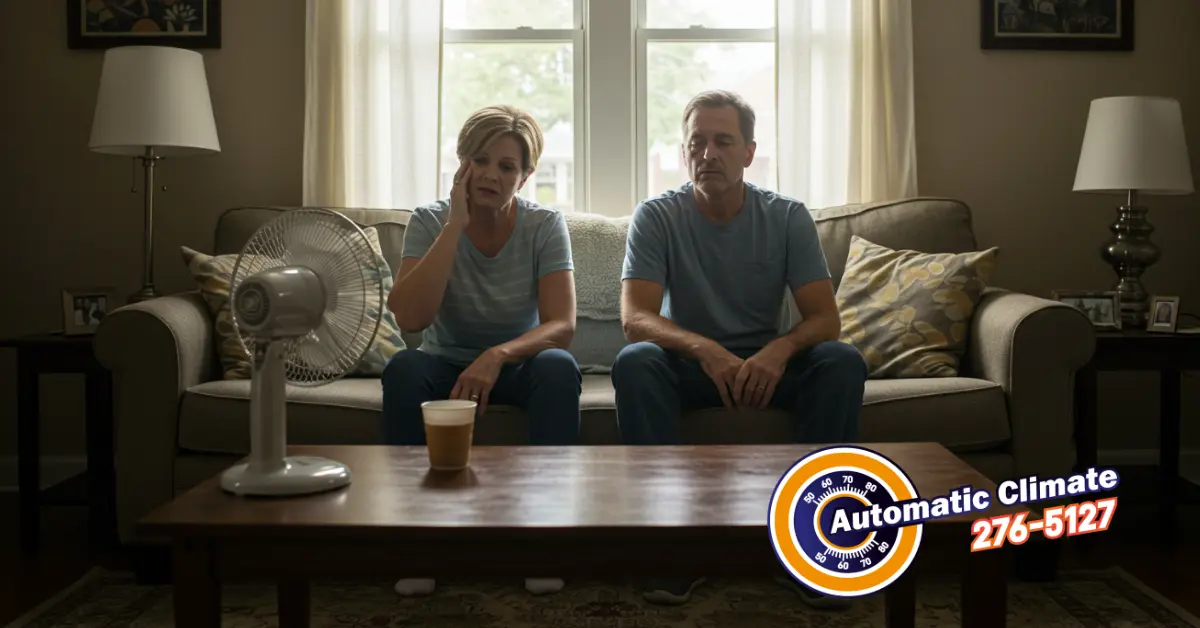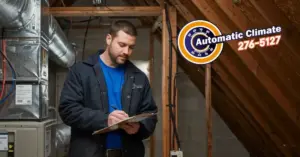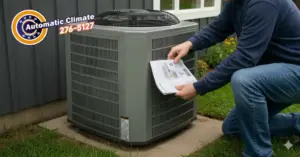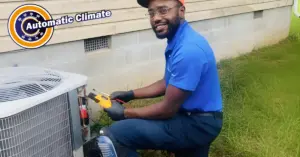Is Your Thermostat Lying? The Real Reason Your Richmond Home Won’t Cool Down
Is your thermostat playing tricks on you? Here in Richmond, when the summer sun beats down, the last thing you want is a home that feels more like a sauna than a sanctuary. You faithfully set your thermostat to a cool 72 degrees, but the air stays stubbornly warm, sticky, and uncomfortable. It’s a frustrating scenario familiar to many homeowners, leading to the inevitable question: Is my thermostat lying? While an inaccurate thermostat can certainly be part of the puzzle, it’s often just one piece. The real reason your Richmond home won’t cool down usually involves a broader need for thorough AC troubleshooting.
Before you declare war on that little box on the wall, let’s dive into the world of home cooling and explore the various factors that could be sabotaging your comfort. Effective AC troubleshooting goes beyond just glancing at the temperature display. It involves understanding how different components of your heating, ventilation, and air conditioning (HVAC) system work together – or sometimes, fail to work together. From simple fixes to more complex mechanical issues, pinpointing the root cause is essential for restoring cool air and peace of mind.
Think of your air conditioner like a car; it requires proper care and attention to perform optimally. Ignoring strange noises, reduced airflow, or inconsistent temperatures is like driving with the check engine light on – you might get away with it for a while, but eventually, a bigger problem is likely brewing. Proactive AC troubleshooting and regular maintenance can often catch minor issues before they escalate into costly breakdowns, especially during peak Richmond heatwaves.
As Thomas Edison famously said, “Opportunity is missed by most people because it is dressed in overalls and looks like work.” Sometimes, the ‘work’ involves looking past the obvious (the thermostat) and investigating the less visible parts of your system. This is where systematic AC troubleshooting becomes invaluable. It could be something as simple as a clogged air filter drastically reducing airflow, or a more technical issue like low refrigerant levels hindering the cooling process.

Here at Automatic Climate HVAC & Air Conditioning, serving the Richmond, VA area since 1983, we’ve seen it all. We understand the unique challenges Richmond weather presents and how crucial a reliable cooling system is. Our experienced technicians are adept at comprehensive AC troubleshooting, quickly diagnosing problems whether they stem from the thermostat, the air handler, the outdoor unit, or the ductwork connecting them all. We believe in empowering homeowners with knowledge, so let’s explore the common culprits behind a home that refuses to cool down. This guide will walk you through key areas of AC troubleshooting, helping you understand potential issues and when it’s time to call in the professionals. We’ll cover thermostat quirks, common system faults, the importance of maintenance, and how to optimize your entire home for better cooling. Don’t let a malfunctioning AC ruin your summer – let’s get to the bottom of it with some smart AC troubleshooting. Identifying common air conditioner problems early is key. This process of AC troubleshooting might seem daunting, but breaking it down step-by-step makes it manageable. Remember, the goal of AC troubleshooting is finding the real reason for the lack of cooling.
Our Trusted Partners
EXCELLENTTrustindex verifies that the original source of the review is Google. Aaron J. Visited our home later this evening to follow up with today’s install and the system checked out as it should. The only issue we had was connecting and setting up the wireless thermostat due to the app issues. He was very professional and patient. John and Joe replaced our 2nd floor gas heating system in a professional manner. Everything went smooth according to them and they finished the job in less time than expected. Aaron was professional and extremely thorough during his visit to our home. He took the time to explain the workings of our HVAC system and answered every question. To add to the above, I called the office and spoke with both Austin and Jason who were also very helpful while explaining the warranty and transfer of same. We are extremely pleased with Automatic Climate and will highly recommend to anyone who may ask for recommendations.
Owner's reply
Thank you for sharing your positive experience! We're thrilled Aaron, Austin, and Jason could assist you so thoroughly. Your recommendation means a lot, and we're glad we could help with your HVAC system and warranty details.Posted onTrustindex verifies that the original source of the review is Google. I had a very positive experience with them. They had better financing options, better prices, and were more responsive than other companies I got quotes from. Michael Chris and the whole team were fantastic. Highly recommendPosted onTrustindex verifies that the original source of the review is Google. Technician was on time, personable and professional. He throughly explained everything that he was going to do and identified any concerns. Very pleased with the overall experience and would recommend to other homeownersPosted onTrustindex verifies that the original source of the review is Google. I had the coils cleaned in my tankless water heater. Aaron Jernigan was so seemingly competent, so well-mannered, so good explaining what was going on, I am considering switching to Automatic Climate, I will definitely have all the vents in my house blown out in the near future.Posted onTrustindex verifies that the original source of the review is Google. Fast, friendly, knowledgeable and professional. Their associate, Casey J, helped fix our heat when we were enduring 20-30 degree nights. Thank you so much!!Posted onTrustindex verifies that the original source of the review is Google. Charlie was very dedicated. Provided excellent service. Very impressed with his dedication. Did check on HVAC and cleaned drier vent in Condo we purchased last summer.Posted onTrustindex verifies that the original source of the review is Google. I've been a customer of Automatic Climate for several years. I value the services of this firm. My commitment to renewing my maintenance contract year after year is directly related to the technical expertise of one of the company’s many representatives, Antonio Diaz. Antonio has kept all three of my units running smoothly for years, and when necessary forewarns me early of any pending issues. He offers solutions right away without long waits for follow up. I've never had to call the company back to correct any of his work. Antonio attributes his success and extraordinary customer service to the culture of Automatic Climate. I would recommend Antonio and Automatic Climate to any of my friends and neighbors. They're a company you can trust.
Owner's reply
Thank you so much for your kind words! We're thrilled to hear you had a positive experience with our service.Posted onTrustindex verifies that the original source of the review is Google. John & Nick were here today to clean our air ducts. They were very thorough and made sure that they left our home as clean as when they arrived. They explained the process clearly and worked efficiently. Great job!Verified by TrustindexTrustindex verified badge is the Universal Symbol of Trust. Only the greatest companies can get the verified badge who has a review score above 4.5, based on customer reviews over the past 12 months. Read more
Understanding the basics of how your AC works is the first step in effective AC troubleshooting. Your system cools your home through a process involving refrigerant, which absorbs heat from inside your house and releases it outside. This cycle relies on several key components: the thermostat (the brain), the evaporator coil (inside, absorbs heat), the condenser coil (outside, releases heat), the compressor (moves refrigerant), and the air handler (circulates air). A problem with any of these can disrupt the entire cooling process, necessitating careful AC troubleshooting. We often find during AC troubleshooting that airflow is restricted, preventing the system from working efficiently. Let’s continue our AC troubleshooting journey by looking at common roadblocks.
Richmond’s humid climate adds another layer of complexity. High humidity makes the air feel warmer and stickier, forcing your AC to work harder not just to lower the temperature but also to remove moisture. If your system isn’t dehumidifying properly (which can be due to various issues identified through AC troubleshooting, like improper sizing or coil problems), your home might feel cool but damp, or simply not cool enough. This is a frequent finding during detailed AC troubleshooting in our area. Therefore, effective AC troubleshooting must also consider the system’s dehumidification performance. Proper AC troubleshooting considers all environmental factors.
Common AC Cooling Roadblocks: Quick Visual Guide
⚠️
Blocked Airflow
Dirty Filters, Blocked Vents, Leaky Ducts
🌡️
Thermostat Issues
Bad Placement, Wrong Calibration, Faulty Sensor
💧
Refrigerant Levels
Low Levels (Leak) Reduce Cooling Power
🌬️
Dirty Coils
Obstructed Heat Transfer (Indoor/Outdoor Units)
📏
Incorrect Unit Size
Oversized or Undersized for Your Home
Source: Based on common issues identified by HVAC professionals like those at Automatic Climate and resources like Energy.gov. This highlights key areas for AC troubleshooting.
Now that we have a visual overview, let’s delve deeper into the thermostat itself. While not always the main villain, it can definitely cause confusion and contribute to cooling problems. Understanding potential thermostat issues is a critical first step in any AC troubleshooting process. You might be surprised how often the perceived problem isn’t a major system failure, but rather a simple thermostat setting or placement issue. Let’s continue our AC troubleshooting focus on this control center.
SKip The Line! Schedule Your HVAC Service by Booking Online Now.
Don’t wait for the perfect temperature! Book your HVAC service online now and choose a day and time that works best for you. Our team at Automatic Climate is ready to ensure your comfort all year round.
Get in Touch
Contact Us
Reach out for expert HVAC solutions and service inquiries.
Is Your Thermostat Really the Culprit? Diving Deeper into Thermostat Troubleshooting
Your thermostat is the command center for your home’s comfort. It senses the ambient temperature and tells your HVAC system when to turn on and off to reach your desired setting. But what happens when this command center gives faulty orders or misreads the situation? This is where specific thermostat AC troubleshooting comes into play.
The Placement Predicament: Location, Location, Location!
One of the most common thermostat-related issues we encounter during AC troubleshooting in Richmond homes is poor thermostat placement. Where your thermostat is located dramatically affects its ability to accurately read your home’s average temperature. Consider these placement pitfalls:
- Direct Sunlight: A thermostat basking in the sun will think the room is much hotter than it actually is, causing your AC to run excessively and potentially short-cycle, or shut off prematurely if it reaches a high limit. Proper AC troubleshooting always checks for sun exposure.
- Near Heat Sources: Placing it near lamps, televisions, kitchen appliances, or even directly above a heat-generating electronic device can skew readings upwards.
- Drafty Areas: Locations near doors, windows, or supply vents can make the thermostat think the room is cooler than it is, preventing the AC from running when needed. Effective AC troubleshooting involves checking for drafts.
- Blocked Airflow: Furniture or curtains obstructing airflow around the thermostat can create a microclimate, leading to inaccurate readings.
The ideal thermostat placement is typically on an interior wall, near the center of your home, in an area with good air circulation, away from direct heat/cold sources. Evaluating this is a quick but crucial AC troubleshooting step.
Calibration Chaos: Is Your Thermostat Telling the Truth?
Over time, thermostats (especially older mechanical ones, but even digital models) can lose their calibration. This means the temperature it displays might not match the actual room temperature. An inaccurate thermostat reading is a prime suspect in AC troubleshooting. You might set it to 72°F, but if it’s calibrated incorrectly and reads 75°F when it’s actually 72°F, it won’t trigger the AC until the room is much warmer than desired.
You can perform a simple calibration check as part of your initial AC troubleshooting: Place a reliable thermometer (like a glass bulb or accurate digital one) right next to your thermostat for about 15-20 minutes. Compare the readings. If they are off by more than a degree or two, calibration might be needed. Some digital thermostats allow for recalibration; older ones might need replacement. This is a common fix during professional AC troubleshooting.
Ghost Readings & Sensor Faults: Internal Gremlins
Sometimes, the issue lies within the thermostat’s internal components. Dust buildup on sensors can interfere with readings. Faulty wiring connections between the thermostat and the HVAC system can cause intermittent signals or complete communication failure. Damaged sensors might provide erratic or completely wrong temperature data. Diagnosing these internal faults requires more technical AC troubleshooting, often best handled by a professional HVAC technician from a trusted company like Automatic Climate. They have the tools and expertise for precise AC troubleshooting of electronic components.
Battery Blues & Power Problems: The Simple Stuff
Never underestimate the simple solutions during AC troubleshooting! Many digital thermostats rely on batteries. Low or dead batteries can cause the display to fade, become unresponsive, or send incorrect signals. Always check and replace batteries as a first step. Additionally, ensure the circuit breaker controlling your HVAC system hasn’t tripped. A loss of power to the system means neither the AC nor the thermostat can function correctly. Checking power is fundamental AC troubleshooting.
While thermostat issues are significant, remember they are just one aspect of comprehensive AC troubleshooting. If you’ve checked these points and your Richmond home still feels like a tropical jungle, it’s time to look beyond the thermostat and investigate the AC system itself. Skilled AC troubleshooting requires looking at the whole picture. Don’t hesitate to contact Automatic Climate at (804) 803-1983 for expert assistance with any level of AC troubleshooting.
Proactive Cooling Care: Essential Maintenance Checklist
✅
Change Air Filters Regularly
Crucial for airflow & efficiency. Check monthly, replace every 1-3 months (or per filter instructions). Key part of avoiding complex AC troubleshooting.
✅
Check & Clean Coils
Keep outdoor (condenser) and indoor (evaporator) coils free of dirt & debris for optimal heat exchange. Essential air conditioner maintenance.
✅
Clear Condensate Drain Line
Prevent water backup, potential shutdowns, and water damage. Check periodically for clogs. Important preventative AC troubleshooting.
✅
Inspect Ductwork
Look for leaks, disconnected sections, or blockages that waste cooled air. Consider professional duct inspection/cleaning.
✅
Schedule Professional Tune-Ups
Annual check-ups catch issues early, ensure efficiency, and prolong system life. The best way to avoid emergency AC troubleshooting. See our maintenance plans.
Source: Recommended practices from Energy.gov and HVAC experts like Automatic Climate. Consistent maintenance minimizes the need for extensive AC troubleshooting.
Following a maintenance schedule is like preventative medicine for your air conditioner. It’s the best defense against unexpected breakdowns and the frustration that comes with needing urgent AC troubleshooting on the hottest Richmond day. Regular checks can significantly improve your system’s efficiency and lifespan. But what happens when, despite your best efforts, the cool air just isn’t flowing? Let’s explore the more complex system faults that require deeper AC troubleshooting.
When the Problem Runs Deeper: Exploring AC System Faults
If your thermostat seems okay and basic maintenance hasn’t solved the cooling conundrum, the next phase of AC troubleshooting involves looking at the core components of the air conditioning system itself. These issues often require professional diagnosis and repair.
The Airflow Obstacle Course: Filters, Vents, and Ducts
We can’t stress this enough: restricted airflow is one of the most frequent culprits found during AC troubleshooting.
- Dirty Air Filters: A clogged filter acts like a chokehold on your system, forcing it to work harder, reducing cooling capacity, potentially causing coils to freeze, and increasing energy bills. Replacing the filter is the simplest, yet most impactful, piece of air conditioner maintenance and basic AC troubleshooting.
- Blocked Vents and Registers: Ensure furniture, rugs, or curtains aren’t blocking the supply or return air vents. Your system needs clear pathways to circulate air effectively. Checking vents is easy AC troubleshooting.
- Leaky or Collapsed Ductwork: Holes, gaps, or disconnected sections in your ducts mean cooled air escapes into attics, crawlspaces, or walls instead of reaching your living areas. This is a major efficiency killer and requires professional duct inspection, often part of advanced AC troubleshooting. Automatic Climate offers duct sealing and repair services.
Refrigerant Riddles: The Lifeblood of Cooling
Refrigerant (often known by brand names like Freon, though newer types are used now) is the substance that absorbs and releases heat. Your AC is designed as a closed system, meaning refrigerant shouldn’t “run out” or be “used up.” If levels are low, it signifies a leak. Signs of low refrigerant discovered during AC troubleshooting include:
- Air blowing cool, but not cold.
- Ice formation on refrigerant lines or coils.
- Hissing or bubbling noises near AC components.
- Increased energy consumption as the system struggles.
Handling refrigerant requires specific certification and tools. Simply adding more refrigerant without fixing the leak is ineffective and environmentally irresponsible. Professional AC troubleshooting by Automatic Climate involves leak detection, repair, and proper recharging according to manufacturer specifications. This detailed AC troubleshooting ensures long-term solutions.
Condenser Coils Caked in Grime: The Outdoor Unit’s Burden
The outdoor unit (condenser) is responsible for releasing the heat absorbed from inside your home. Its coils are exposed to dirt, leaves, pollen, grass clippings, and other debris. A layer of grime acts as an insulator, preventing efficient heat release. This forces the system to work harder and reduces cooling capacity. Cleaning the condenser coils is a vital part of air conditioner maintenance and effective AC troubleshooting. While homeowners can gently rinse coils (power off first!), professional cleaning during a tune-up is more thorough. Neglected coils are a common finding in AC troubleshooting calls.
Evaporator Coils Freezing Over? A Symptom, Not the Disease
Finding ice on the indoor evaporator coil is a clear sign something is wrong, often discovered during AC troubleshooting. However, the ice itself isn’t the root problem; it’s usually a symptom of restricted airflow (dirty filter, blocked vents) or low refrigerant. When airflow is insufficient, the coil gets too cold, and moisture freezes on contact. Similarly, low refrigerant can cause pressure drops that lead to freezing. Running the AC with frozen coils can severely damage the compressor. If you see ice, turn off the AC and switch the fan to ‘ON’ to help it thaw, then investigate the underlying cause – a critical AC troubleshooting step before calling for service. This prevents further damage while awaiting professional AC troubleshooting.
As Albert Einstein noted, “We cannot solve our problems with the same thinking we used when we created them.” If basic checks don’t work, a deeper level of AC troubleshooting thinking is needed, often requiring professional tools and knowledge. Tackling these more complex system faults requires expertise. For reliable AC troubleshooting and repairs in Richmond, trust the experienced team at Automatic Climate. Call us at (804) 803-1983. Effective AC troubleshooting is our specialty.
Stop Sweating, Start Cooling!
Feeling the Richmond heat? Is your thermostat causing confusion, or is your AC just not keeping up? Don’t endure another uncomfortable day!
The expert technicians at Automatic Climate HVAC & Air Conditioning are ready to provide fast, reliable AC troubleshooting and repair services. With experience dating back to 1983, we know Richmond HVAC systems inside and out.
We offer comprehensive diagnostics to find the real reason your home won’t cool down. From thermostat checks to complex system repairs and essential air conditioner maintenance, we’ve got you covered.
Or Call Us Now: (804) 803-1983
Trust Automatic Climate for all your Richmond AC troubleshooting needs!
Case Study: The Mystery of the Warm West End Home
The Problem: A homeowner in Richmond’s West End contacted Automatic Climate, frustrated that their house felt consistently warm (around 78°F) despite setting the thermostat to 70°F. Their energy bills were also unusually high. Initial checks confirmed the thermostat batteries were new and it seemed responsive.
Our AC troubleshooting Process: An Automatic Climate technician performed a comprehensive system evaluation.
- Thermostat check: Confirmed proper thermostat placement and basic function.
- Filter inspection: Found a severely clogged air filter, significantly restricting airflow.
- System diagnostics: Pressure readings indicated the refrigerant level was slightly low.
- Leak detection: A small leak was identified at a service valve connection.
The Solution:
- Replaced the dirty air filter immediately.
- Repaired the refrigerant leak at the valve.
- Recharged the system to the manufacturer’s specified refrigerant level.
- Performed a final check of airflow and temperature differentials.
The Result: Within an hour of completing the AC troubleshooting and repairs, the home began cooling effectively, reaching the desired 70°F setting. The homeowner reported significantly improved comfort and noted a drop in their energy bill the following month. This case highlights how multiple issues can contribute to poor cooling and why thorough AC troubleshooting is essential.
Source: Based on typical service calls handled by Automatic Climate.
This case study illustrates a common scenario: the problem wasn’t a single “lying” thermostat but a combination of maintenance neglect (the filter) and a developing mechanical issue (the leak). Effective AC troubleshooting uncovered both, leading to a complete solution. Now, let’s consider some broader factors related to your home and system that influence cooling performance and are part of holistic AC troubleshooting.
Optimizing Your Richmond Home for Cool Comfort: Beyond Basic Repairs
Effective cooling isn’t just about fixing broken parts; it’s also about ensuring your entire home environment and HVAC system are set up for success. Advanced AC troubleshooting sometimes reveals that the core issue isn’t a malfunction but rather a mismatch or inefficiency in the overall setup.
Is Your AC Unit the Right Size? The Goldilocks Principle
An air conditioner that’s too small for your home will struggle constantly, running non-stop without ever reaching the target temperature, leading to high energy bills and premature wear. Conversely, an oversized unit might cool the air quickly but shut off before adequately dehumidifying, leaving your home feeling cool but clammy. This rapid on-off cycling (short-cycling) is also inefficient and hard on components. Determining the correct AC size requires a professional load calculation (Manual J calculation) considering factors like square footage, insulation levels, window types, orientation, and Richmond’s climate. Incorrect sizing is a crucial factor considered during comprehensive AC troubleshooting, especially for persistent comfort issues. If you suspect sizing issues, consult Automatic Climate for an evaluation. Proper sizing is fundamental, often overlooked in basic AC troubleshooting.
The Undeniable Importance of Regular Air Conditioner Maintenance
We’ve touched on maintenance, but its importance cannot be overstated as the ultimate preventative AC troubleshooting measure. Annual professional tune-ups are essential. During a maintenance visit, technicians like ours at Automatic Climate perform tasks that go beyond basic filter changes:
- Cleaning condenser and evaporator coils thoroughly.
- Checking refrigerant levels and pressures (identifying potential leaks early).
- Inspecting electrical connections and tightening them.
- Lubricating moving parts like motors.
- Checking thermostat calibration and function.
- Inspecting the condensate drain to prevent clogs and water damage.
- Testing system controls and safety switches.
Regular air conditioner maintenance keeps your system running efficiently, extends its lifespan, improves indoor air quality, and drastically reduces the likelihood of needing emergency AC troubleshooting during peak season. Consider it an investment, not an expense. Explore our maintenance agreements for convenient, scheduled care. Avoiding just one major repair often pays for years of maintenance, making it the smartest AC troubleshooting strategy.
Sealing the Envelope: How Air Leaks and Insulation Impact Cooling
Your AC can be working perfectly, but if your home is poorly sealed or insulated, that precious cool air is escaping while hot, humid Richmond air infiltrates. This forces your system to run longer and harder. Part of holistic AC troubleshooting involves considering the building envelope:
- **Air Leaks:** Check for drafts around windows, doors, electrical outlets, plumbing penetrations, and attic access points. Use caulk and weatherstripping to seal gaps.
- **Insulation:** Ensure adequate insulation levels, particularly in the attic, which bears the brunt of summer heat gain. Proper insulation significantly reduces the cooling load on your AC.
Improving your home’s seal and insulation can dramatically enhance comfort and reduce cooling costs, complementing your mechanical AC troubleshooting efforts.
Considering an Upgrade? When AC Troubleshooting Isn’t Enough
Air conditioners don’t last forever. If your system is over 10-15 years old, requires frequent repairs, uses outdated refrigerant (like R-22, which is being phased out), or struggles significantly even after thorough AC troubleshooting and repairs, it might be time to consider replacement. Newer systems offer vastly improved energy efficiency (higher SEER ratings), better humidity control, quieter operation, and advanced features like variable-speed motors. While an upfront investment, a new, correctly sized and installed system from Automatic Climate can lead to substantial long-term savings on energy bills and eliminate the constant headache of AC troubleshooting.
As Benjamin Franklin wisely put it, “An ounce of prevention is worth a pound of cure.” This applies perfectly to HVAC systems. Regular maintenance and addressing minor issues promptly are far better than dealing with major failures. However, when problems do arise, systematic AC troubleshooting is key. Whether it’s a thermostat adjustment, a filter change, or a more complex repair, understanding the potential causes helps you communicate effectively with professionals like us at Automatic Climate. Trust our team for honest assessments and expert AC troubleshooting in Richmond. Our goal is always effective AC troubleshooting leading to reliable comfort.
Frequently Asked Questions About Richmond AC Troubles & AC Troubleshooting
1. Why is my AC running but not cooling my Richmond home?
This common issue requires AC troubleshooting. Causes include dirty air filters restricting airflow, low refrigerant levels (indicating a leak), dirty condenser coils preventing heat release outdoors, or problems with the compressor or fan motor.
2. How often should I change my air filter in Richmond?
It depends on the filter type and household factors (pets, allergies). Generally, check basic 1-inch filters monthly and replace every 1-3 months. Higher quality pleated filters might last longer (3-6 months). Regular changes are crucial preventative AC troubleshooting.
3. How can I tell if my thermostat is inaccurate?
Place a known accurate thermometer next to your thermostat for 15-20 minutes. If the readings differ by more than 2 degrees, it might need calibration or replacement. This is a simple AC troubleshooting check. See The Spruce guide.
4. What are signs of low refrigerant in my AC?
Signs include lukewarm air from vents, ice on refrigerant lines/coils, hissing sounds, and longer run times. Low refrigerant means a leak, requiring professional AC troubleshooting and repair by certified technicians like those at Automatic Climate.
5. My outdoor unit isn’t running, what should I check?
First steps in AC troubleshooting: Check your thermostat settings (is it set to COOL and below room temp?). Check the circuit breakers for both the indoor and outdoor units. Check the outdoor unit’s disconnect switch (usually a box near the unit). If these are okay, call a professional.
6. Why is regular AC maintenance so important?
It ensures efficiency, prevents breakdowns, extends system lifespan, maintains warranties, and improves air quality. It’s proactive AC troubleshooting, saving money and hassle long-term. See Energy.gov for tips.
7. What does an AC tune-up involve?
A typical tune-up from Automatic Climate includes cleaning coils, checking refrigerant, inspecting electrical parts, lubricating motors, checking airflow, testing controls, and inspecting the condensate drain – comprehensive preventative AC troubleshooting.
8. How do leaky air ducts affect cooling?
Leaky ducts can lose 20-30% of the cooled air into unconditioned spaces like attics or crawlspaces. This wastes energy, reduces comfort, and forces your AC to work harder. Duct inspection is part of thorough AC troubleshooting.
9. When should I consider replacing my air conditioner?
Consider replacement if it’s over 10-15 years old, needs frequent or costly repairs, uses R-22 refrigerant, or struggles to cool your home effectively even after AC troubleshooting.
10. Are smart thermostats worth the investment?
Often, yes. They offer programmability, remote access, learning capabilities, and energy usage reports, potentially saving money and improving comfort. They can also aid in remote AC troubleshooting diagnostics.
11. Can I perform AC troubleshooting myself?
Basic AC troubleshooting like checking filters, thermostat settings, breakers, and clearing debris around the outdoor unit is safe for homeowners. More complex issues involving electrical components or refrigerant require a trained professional.
12. Why is my AC freezing up?
Usually due to restricted airflow (dirty filter/blocked vents) or low refrigerant. Turn off the AC, turn the fan ‘ON’ to thaw, check/replace the filter. If it persists, call for professional AC troubleshooting.
13. What’s that noise my AC is making?
Different noises indicate different problems during AC troubleshooting. Hissing = likely refrigerant leak. Banging/clanking = loose/damaged part (e.g., compressor, fan blade). Buzzing = electrical issue. Screeching = motor bearing problem. Turn off the unit and call a pro.
14. How does Richmond humidity affect my AC?
High humidity makes your AC work harder to remove moisture, impacting perceived coolness. Ensure your system is sized correctly and the condensate drain is clear. Proper AC troubleshooting considers dehumidification performance.
15. Does Automatic Climate offer emergency AC service?
Yes, we understand HVAC emergencies happen. Visit our after-hours service page or call (804) 803-1983 for urgent AC troubleshooting needs in the Richmond area.
16. What areas does Automatic Climate serve around Richmond?
We proudly serve Richmond and surrounding communities. Visit our About Us page or contact us for specific service area details for your AC troubleshooting needs.
17. Can dirty ducts make my house feel warmer?
While primarily an air quality issue, severely clogged or leaky ducts can restrict airflow enough to impact cooling performance, making duct inspection part of comprehensive AC troubleshooting.
18. Is my thermostat compatible with my HVAC system?
Not all thermostats work with all systems (e.g., heat pumps, multi-stage units). Compatibility issues can cause malfunction. Professional AC troubleshooting includes checking compatibility if a new thermostat was recently installed.
19. What is SEER rating and why does it matter?
SEER (Seasonal Energy Efficiency Ratio) measures an AC’s cooling output over a season divided by energy consumed. Higher SEER = more efficient. Considering SEER is important when replacing a unit after extensive AC troubleshooting reveals inefficiencies.
20. Why should I choose Automatic Climate for AC troubleshooting in Richmond?
With experience since 1983, certified technicians, a commitment to customer satisfaction (see our guarantee), and comprehensive services, we provide reliable, expert AC troubleshooting and solutions tailored to Richmond homes. Call us at (804) 803-1983.
Have more questions? Contact the AC troubleshooting experts at Automatic Climate!
Further Reading & Resources
For more information on related topics, explore these resources from reputable national outlets:
- CNET: What to do when your thermostat is wrong – Discusses common reasons for inaccurate readings.
- Energy.gov: Common Air Conditioner Problems – Official advice on identifying and addressing AC issues.
- HowStuffWorks: 5 Reasons Why Your Air Conditioner Stopped Working – Explains common failure points.
- The Spruce: How to Test and Calibrate a Thermostat – DIY guide for checking thermostat accuracy.
- SaveOnEnergy: Best Placement for Your Thermostat – Details the importance of location.
- Trane: Busting Common Thermostat HVAC Myths – Dispels common misconceptions about thermostats and HVAC operation.
#ACtroubleshooting #RichmondVA #HVAC #AirConditioning #HomeCooling #Thermostat #AutomaticClimate #StayCoolRVA #EnergyEfficiency #HVACrepair #ACmaintenance
Legal Disclaimer: The information provided in this article is intended for general informational purposes only. While we strive to provide accurate and up-to-date information, HVAC systems are complex, and diagnosing specific issues requires professional expertise. Always consult with a qualified HVAC technician, like the team at Automatic Climate HVAC & Air Conditioning, for accurate diagnosis, repairs, and maintenance of your system. Performing complex repairs yourself can be dangerous and may void warranties. Automatic Climate is not liable for any actions taken based on the information presented here. For service in the Richmond, VA area, please call us at (804) 803-1983 or visit www.automaticclimate.com.
Our Trusted Partners
EXCELLENTTrustindex verifies that the original source of the review is Google. Aaron J. Visited our home later this evening to follow up with today’s install and the system checked out as it should. The only issue we had was connecting and setting up the wireless thermostat due to the app issues. He was very professional and patient. John and Joe replaced our 2nd floor gas heating system in a professional manner. Everything went smooth according to them and they finished the job in less time than expected. Aaron was professional and extremely thorough during his visit to our home. He took the time to explain the workings of our HVAC system and answered every question. To add to the above, I called the office and spoke with both Austin and Jason who were also very helpful while explaining the warranty and transfer of same. We are extremely pleased with Automatic Climate and will highly recommend to anyone who may ask for recommendations.
Owner's reply
Thank you for sharing your positive experience! We're thrilled Aaron, Austin, and Jason could assist you so thoroughly. Your recommendation means a lot, and we're glad we could help with your HVAC system and warranty details.Posted onTrustindex verifies that the original source of the review is Google. I had a very positive experience with them. They had better financing options, better prices, and were more responsive than other companies I got quotes from. Michael Chris and the whole team were fantastic. Highly recommendPosted onTrustindex verifies that the original source of the review is Google. Technician was on time, personable and professional. He throughly explained everything that he was going to do and identified any concerns. Very pleased with the overall experience and would recommend to other homeownersPosted onTrustindex verifies that the original source of the review is Google. I had the coils cleaned in my tankless water heater. Aaron Jernigan was so seemingly competent, so well-mannered, so good explaining what was going on, I am considering switching to Automatic Climate, I will definitely have all the vents in my house blown out in the near future.Posted onTrustindex verifies that the original source of the review is Google. Fast, friendly, knowledgeable and professional. Their associate, Casey J, helped fix our heat when we were enduring 20-30 degree nights. Thank you so much!!Posted onTrustindex verifies that the original source of the review is Google. Charlie was very dedicated. Provided excellent service. Very impressed with his dedication. Did check on HVAC and cleaned drier vent in Condo we purchased last summer.Posted onTrustindex verifies that the original source of the review is Google. I've been a customer of Automatic Climate for several years. I value the services of this firm. My commitment to renewing my maintenance contract year after year is directly related to the technical expertise of one of the company’s many representatives, Antonio Diaz. Antonio has kept all three of my units running smoothly for years, and when necessary forewarns me early of any pending issues. He offers solutions right away without long waits for follow up. I've never had to call the company back to correct any of his work. Antonio attributes his success and extraordinary customer service to the culture of Automatic Climate. I would recommend Antonio and Automatic Climate to any of my friends and neighbors. They're a company you can trust.
Owner's reply
Thank you so much for your kind words! We're thrilled to hear you had a positive experience with our service.Posted onTrustindex verifies that the original source of the review is Google. John & Nick were here today to clean our air ducts. They were very thorough and made sure that they left our home as clean as when they arrived. They explained the process clearly and worked efficiently. Great job!Verified by TrustindexTrustindex verified badge is the Universal Symbol of Trust. Only the greatest companies can get the verified badge who has a review score above 4.5, based on customer reviews over the past 12 months. Read more
SKip The Line! Schedule Your HVAC Service by Booking Online Now.
Don’t wait for the perfect temperature! Book your HVAC service online now and choose a day and time that works best for you. Our team at Automatic Climate is ready to ensure your comfort all year round.
Get in Touch
Contact Us
Reach out for expert HVAC solutions and service inquiries.











